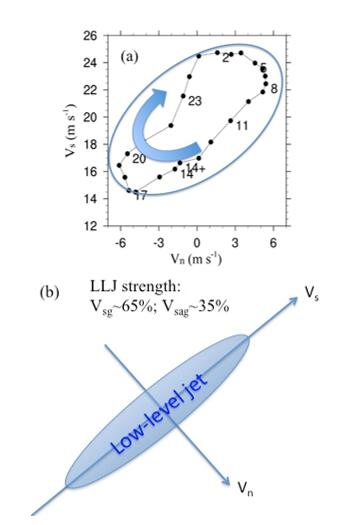Scientists Revealed the Evolution of a typical Low-level Jet Event along the Yun-Gui Plateau in South China
Date:2016-12-08
The low-Level jet (LLJ) frequently happens in South China. It is closely related to severe rainfall events, air pollution, wind energy utilization, aviation safety, and other weather and climate phenomena. Therefore, it has attracted considerable attention since its discovery. However, the LLJ study in China is still far from satisfied, including the coarse LLJ definition, lack of high-resolution observations, the limited study of LLJ formation mechanisms, as well as the effects of complex topography on LLJ evolutions.
Based on the large-scale analysis and a high-resolution model simulation, Dr. LIU Hongbo and her graduate student HE Mingyang from Institute of Atmospheric Physics and their collaborators have demonstrated the three-dimensional structures and diurnal evolution of a typical LLJ in South China. The results indicates that the LLJ reaches its peak intensity of greater than 24 m s-1 at 850 hPa near 0200 LST, with the wind directions veering from southerly before sunset to southwesterly at midnight. In the LLJ coordinates, both the along Vs and normal Vn components of the horizontal wind at the core region have a diurnal variation of about 11 m s-1 with cyclonic rotation (Fig. 1a). They found that in an LLJ coordinates systems the along-LLJ geostrophic component regulates the distribution and 65% of the intensity of LLJ, whereas the ageostrophic component contributes to the clockwise rotation, thus leading to the formation and weakening of the LLJ during nigh- and daytime, respectively (Fig. 1b). A series of numerical sensitivity experiments confirm the surface radiative heating as the key factor in determining the formation of the nocturnal LLJ. The existence of the Yun-Gui Plateau, and the downstream condensational heating along the mei-yu front play secondary roles in the LLJ formation.

Figure 1. (a) a hodograph at hourly intervals taken at 850 hPa at Shaoyang (the LLJ core region), and (b) a schematic diagram of the LLJ coordinates and the contribution of geostrophic and ageostrophic wind components to LLJ peak intensity from the WRF simulation during the period of 1400 LST 29 - 1400 LST 30 June 2003. (Image by LIU Hongbo)
This study was published in Journal of Applied Meteorology and Climatology.
Reference:
He, M.-Y., H.-B. Liu, B. Wang, and D.-L. Zhang (2016), A modeling study of a low-level jet along the Yun-Gui Plateau in South China. J. Appl. Meteor. Cli., 55(1), 41-60. http://journals.ametsoc.org/doi/full/10.1175/JAMC-D-15-0067.1
Contact: Dr.LIU Hongbo, hongboliu@mail.iap.ac.cn
